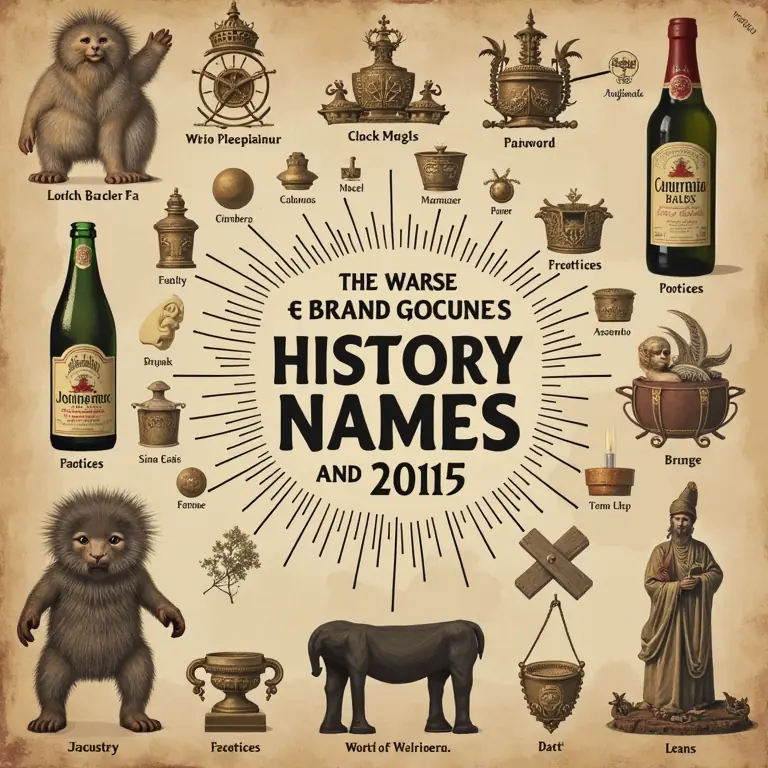We interact with brand names constantly. They’re woven into the fabric of our daily lives, influencing our choices in everything from groceries to gadgets. But have you ever stopped to consider *why* these names are what they are? Beyond clever marketing, a surprising amount of consistency runs through the etymology of brand names, rooted in historical linguistic trends, cultural associations, and even psychological principles that stretch back centuries. This article delves into the fascinating history of how we name things, and how that history continues to shape what we buy today.
The Ancient Roots of Branding: Beyond the Logo
While the modern concept of “branding” is relatively new, the practice of marking goods dates back to antiquity. Ancient potters, for example, would often mark their wares with unique symbols. Livestock branding, originating in ancient Egypt and becoming widespread in the Roman Empire, served a practical purpose – identification and ownership. These early marks weren’t about creating a lifestyle image, but about establishing authenticity and preventing theft. However, even then, the *choice* of mark wasn’t arbitrary. Symbols held cultural meaning, and a carefully chosen mark could imply quality or origin. This foreshadows the modern use of brand names to convey specific attributes.
The medieval guild system further refined this. Guilds, representing craftspeople like blacksmiths or weavers, regulated quality and often required members to mark their products. These marks weren’t just identifiers; they were statements of adherence to guild standards – a rudimentary form of quality assurance and brand reputation. Think of it as the earliest form of a ‘seal of approval’.
The Rise of Proper Names & Family Businesses
The transition from symbolic marks to proper names as brand identifiers began with the rise of family businesses during the late medieval and Renaissance periods. When a family dedicated generations to a particular craft, their name became synonymous with the quality of their goods. Consider names like “Gucci” or “Ferragamo” – they started as the surnames of the families who founded the businesses, and the association with their personal reputation was crucial to their success. This is where we see a shift towards building a brand around a *person*, rather than just a product.
This trend was fueled by increasing literacy and the development of trade routes. As goods traveled further, the need for recognizable identifiers grew. A family name, consistently applied to a product, offered a level of trust and accountability that a simple symbol couldn’t provide. Early advertising, often in the form of shop signs, emphasized the name of the proprietor, reinforcing this association.
The 18th and 19th Centuries: Industrialization and the Need for Differentiation
The Industrial Revolution dramatically accelerated the need for distinct brand names. Mass production meant that goods were no longer unique, handcrafted items. Manufacturers needed a way to differentiate their products from the competition. This led to a surge in the creation of new brand names, often employing several key strategies.
- Descriptive Names: Many early brands adopted names that directly described the product or its function. “British Petroleum” clearly indicated the origin and nature of the company’s business. “Kodak” (George Eastman’s attempt to create a catchy, memorable sound) initially was linked to the photographic process.
- Geographical Names: Leveraging the perceived quality associated with a particular region was common. “Swiss Army Knife” immediately evokes images of precision engineering and reliability.
- Founder’s Names: As mentioned before, this continued to be a popular choice, lending an air of personal responsibility and tradition.
- Invented Names: As competition intensified, manufacturers began to create entirely new names, often designed to be memorable and easy to pronounce.
This period also saw the emergence of early trademark laws, offering legal protection for brand names and logos. This was a crucial step in establishing the modern concept of intellectual property and reinforcing the value of a strong brand identity.
The Psychological Impact of Brand Names: Sound, Meaning, and Association
The creation of brand names isn’t solely a matter of practicality; it’s deeply rooted in psychology. The sounds of a name can influence our perception of a product. Names with hard consonants (like “Kraft”) are often perceived as strong and reliable, while those with softer sounds (like “Dove”) evoke feelings of gentleness and care. This is an area explored in the study of perceptual psychology, demonstrating how our brains fill in gaps and make assumptions based on incomplete information – including the sounds of words.
The meaning (or perceived meaning) of a name also plays a vital role. Names derived from classical mythology or historical figures can imbue a brand with connotations of prestige and sophistication. Consider brands like “Nike” (named after the Greek goddess of victory) or “Amazon” (evoking the vastness and power of the Amazon River).
Furthermore, brands leverage the power of association. By linking their name to positive experiences or desirable qualities, they can create a positive emotional connection with consumers. This is where storytelling becomes crucial – brands craft narratives around their names, reinforcing their desired image.
The 20th Century: Branding as a Science
The 20th century witnessed the professionalization of branding. Advertising agencies began to employ psychologists and market researchers to develop brand names that maximized appeal. The focus shifted from simply identifying a product to creating a comprehensive brand identity, encompassing everything from logo design to advertising campaigns.
The rise of mass media (radio, television, and later the internet) amplified the impact of brand names. Repetitive advertising and carefully crafted messaging cemented certain brands into the collective consciousness. Brands became symbols of status, aspiration, and belonging.
This era also saw the emergence of “lifestyle brands” – brands that didn’t just sell products but sold a way of life. Harley-Davidson, for example, doesn’t just sell motorcycles; it sells a sense of freedom, rebellion, and camaraderie. The brand name became shorthand for these values.

Modern Trends: Minimalism, Authenticity, and the Digital Landscape
Today, brand naming trends reflect a growing desire for authenticity and transparency. Consumers are increasingly skeptical of overly polished marketing campaigns and are drawn to brands that appear genuine and relatable.
- Minimalist Names: Shorter, simpler names are becoming increasingly popular. This reflects a desire for clarity and efficiency in a cluttered marketplace. Think of brands like “Apple” or “Tesla”.
- Storytelling & Heritage: Brands are increasingly emphasizing their history and values. Highlighting a founder’s story or a commitment to sustainability can resonate with consumers.
- Personalization: The digital landscape allows for greater personalization. Brands are using data to tailor their messaging and create more targeted experiences.
- Abstract Names: Invented names continue to be popular, but they often prioritize memorability and pronounceability over direct meaning.
The rise of social media has also fundamentally changed the brand-consumer relationship. Brands are now expected to engage in two-way conversations with their customers, fostering a sense of community and building trust.
The Enduring Consistency: Linguistic Patterns and Archetypes
Despite the evolving landscape, certain patterns persist in brand naming. The use of evocative language, the appeal to universal archetypes, and the manipulation of sound and meaning remain central to the process. These patterns are rooted in the fundamental ways our brains process information and make decisions. Consider the enduring popularity of names that evoke feelings of security, trust, and belonging.
The consistency extends to the types of names chosen across different cultures. While specific sounds and meanings may vary, the underlying principles remain remarkably similar. For example, the use of nature-inspired names (like “River” or “Forest”) is common across many cultures, tapping into a universal appreciation for the natural world.
This isn’t accidental. The human brain is hardwired to respond to certain stimuli in predictable ways. Brand namers, consciously or unconsciously, leverage these predispositions to create names that resonate with consumers.
The Legacy of Mapmaking and the Art of Symbolic Representation
Interestingly, the principles behind effective brand naming share similarities with the art of cartography, particularly early mapmaking. Just as mapmakers used symbols to represent complex geographical features, brand namers use words and imagery to represent complex brand attributes. Both rely on a shared understanding of meaning and association. The careful selection of symbols in early maps, discussed in the history of cartography, mirrors the careful selection of words in brand naming – both aim to convey information efficiently and effectively.
The Future of Brand Names: AI and the Search for the “Perfect” Name
The future of brand naming is likely to be shaped by artificial intelligence. AI-powered tools are already being used to generate and evaluate potential brand names, analyzing vast datasets of linguistic data and consumer preferences. These tools can identify names that are memorable, pronounceable, and aligned with a brand’s desired image.
However, even with the advent of AI, the human element will remain crucial. Ultimately, a successful brand name must resonate with people on an emotional level. It must tell a story, evoke a feeling, and create a connection. While AI can assist in the process, it cannot replicate the creativity and intuition of a skilled brand namer.
Beyond Names: The Consistency of Design and Sensory Experience
It’s important to note that brand naming is just one piece of the puzzle. The overall sensory experience – including logo design, packaging, color palettes, and even scent – contributes to a brand’s identity. The meticulous formulation of vintage perfumes, explored in the science of vintage perfume formulation, demonstrates how carefully considered sensory details can create a lasting impression. Consistency across all these elements is essential for building a strong and recognizable brand.
The Enduring Power of Playful Forms: From Game Pieces to Brand Aesthetics
The shapes and forms used in branding, from logo design to product packaging, also exhibit surprising consistency. The evolution of board game pieces, detailed in the history of board game pieces, reveals a preference for archetypal forms that are easily recognizable and emotionally engaging. This same principle applies to branding – simple, memorable shapes are often more effective than complex designs.
The Knot of Branding: Complexity and Connection
Even the concept of tying things together, as seen in the intricate art of knot tying in sailing, described in the science of knot tying, resonates with branding. A strong brand ties together a cohesive narrative, consistent values, and a memorable identity. The complexity of a well-tied knot mirrors the multifaceted nature of a successful brand.
In conclusion, the etymology of brand names is far more than a random collection of words. It’s a reflection of our history, our psychology, and our enduring need to connect with something meaningful. By understanding the historical and cultural forces that have shaped brand naming, we can gain a deeper appreciation for the power of these seemingly simple identifiers and how they continue to shape our world.


 The Curious Acoustics of Historical Echo Chambers: Resonance, Ritual, and Revelation
The Curious Acoustics of Historical Echo Chambers: Resonance, Ritual, and Revelation  The Curious Cartography of Scent: Mapping Perfume Ingredients Through History
The Curious Cartography of Scent: Mapping Perfume Ingredients Through History  The Curious Lexicon of Lost Trades
The Curious Lexicon of Lost Trades  The Surprisingly Consistent Science of Historical Ice Harvesting – A Frozen History of Commerce & Preservation
The Surprisingly Consistent Science of Historical Ice Harvesting – A Frozen History of Commerce & Preservation  The Unexpectedly Consistent Science of Historical Buttonhooks – Fashion, Function & Forgotten Tools
The Unexpectedly Consistent Science of Historical Buttonhooks – Fashion, Function & Forgotten Tools  The Surprisingly Consistent Science of Historical Toy Soldiers – Miniature Warfare, Materials & Collective Play
The Surprisingly Consistent Science of Historical Toy Soldiers – Miniature Warfare, Materials & Collective Play